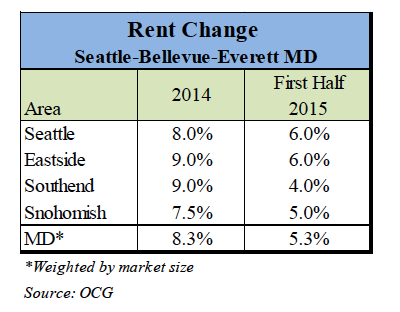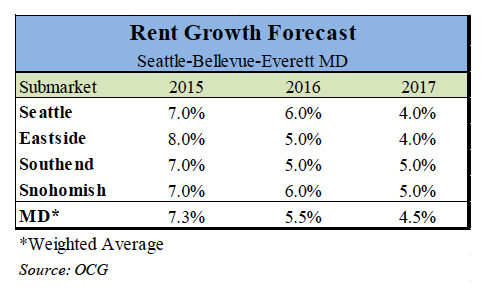Reality Check: Will MIZ Erase Gains in Affordability in Years Ahead?
I’ve been reviewing a 2015 market study by the O’Connor Group (OCG) that considered historical trends and made some forecasts for a period ending in 2017. I don’t have the latest survey, but I think it’s worth looking at these numbers as we prepare for 2017. When I consider this data I find myself hopeful about prices for housing in the city — then I consider what policy makers are doing with Mandatory Inclusionary Zoning (MIZ) and other measures and I can see that we’re doing with our housing policy that exact opposite of what we should be doing. Here’s a look at vacancy rates and how they relate to prices. The OCG study points out that, “In general, there is clear relationship between vacancy rates and rent changes. When vacancy drops below 5.0%, rents will start to climb.”
Retrospectively, here’s what’s happened with rents over the last couple years.
And here is where things are going in the year ahead:
While vacancy rates in Seattle will remain below that 5 percent (about 3.9 percent over the two year period they review) that OCG identifies as the threshold for prices flattening and dropping, they show rent increases cooling off. That’s good news.
But the problem is that this projection does not take into consideration the new Mandatory Inclusionary Zoning (MIZ). True, the goal is to impose MIZ sometime in 2017, when much of the supply has been accounted for in these projections. If the Seattle City Council and Mayor had their way, MIZ would be up and running within the first half of 2017, and all projects would be subject to it all over the city. How would the additional costs of inclusion and fees impact that 4 percent? We don’t know. And the City bureaucrats pay zero attention to market data.
So what looks like a hopeful trend in the market data — vacancies in Seattle are steadying and price increases are slowing — might well change if the City (and the signers of the Grand Bargain) get their way. The real disaster here is two fold, first nobody is actually paying attention to the information that real human beings investing money use to project supply and demand. Instead policy makers are relying on anecdote and panic and old census data.
But worse, the increases in prices we’ve seen in the here and now are being treated as if they are the way the market will be forever. It won’t. Things change and so do prices. It’s kind of like the City was developing a space program based on the idea that the Earth is the center of the solar system — it isn’t. And any rocket we would put into space on a Ptolemaic set of assumptions would surely fail. Similarly, we’re building a fancy new policy, MIZ, with no attention to whether it will help prices only whether it makes political sense. That means making things worse when the market itself is building momentum to make it better.



